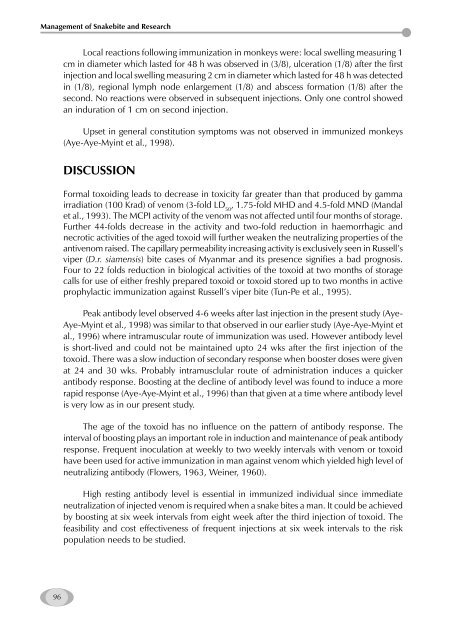Management of Snakebite and Research Management of Snakebite ...
Management of Snakebite and Research Management of Snakebite ...
Management of Snakebite and Research Management of Snakebite ...
You also want an ePaper? Increase the reach of your titles
YUMPU automatically turns print PDFs into web optimized ePapers that Google loves.
<strong>Management</strong> <strong>of</strong> <strong>Snakebite</strong> <strong>and</strong> <strong>Research</strong><br />
96<br />
Local reactions following immunization in monkeys were: local swelling measuring 1<br />
cm in diameter which lasted for 48 h was observed in (3/8), ulceration (1/8) after the first<br />
injection <strong>and</strong> local swelling measuring 2 cm in diameter which lasted for 48 h was detected<br />
in (1/8), regional lymph node enlargement (1/8) <strong>and</strong> abscess formation (1/8) after the<br />
second. No reactions were observed in subsequent injections. Only one control showed<br />
an induration <strong>of</strong> 1 cm on second injection.<br />
Upset in general constitution symptoms was not observed in immunized monkeys<br />
(Aye-Aye-Myint et al., 1998).<br />
DISCUSSION<br />
Formal toxoiding leads to decrease in toxicity far greater than that produced by gamma<br />
irradiation (100 Krad) <strong>of</strong> venom (3-fold LD 50 , 1.75-fold MHD <strong>and</strong> 4.5-fold MND (M<strong>and</strong>al<br />
et al., 1993). The MCPI activity <strong>of</strong> the venom was not affected until four months <strong>of</strong> storage.<br />
Further 44-folds decrease in the activity <strong>and</strong> two-fold reduction in haemorrhagic <strong>and</strong><br />
necrotic activities <strong>of</strong> the aged toxoid will further weaken the neutralizing properties <strong>of</strong> the<br />
antivenom raised. The capillary permeability increasing activity is exclusively seen in Russell’s<br />
viper (D.r. siamensis) bite cases <strong>of</strong> Myanmar <strong>and</strong> its presence signifies a bad prognosis.<br />
Four to 22 folds reduction in biological activities <strong>of</strong> the toxoid at two months <strong>of</strong> storage<br />
calls for use <strong>of</strong> either freshly prepared toxoid or toxoid stored up to two months in active<br />
prophylactic immunization against Russell’s viper bite (Tun-Pe et al., 1995).<br />
Peak antibody level observed 4-6 weeks after last injection in the present study (Aye-<br />
Aye-Myint et al., 1998) was similar to that observed in our earlier study (Aye-Aye-Myint et<br />
al., 1996) where intramuscular route <strong>of</strong> immunization was used. However antibody level<br />
is short-lived <strong>and</strong> could not be maintained upto 24 wks after the first injection <strong>of</strong> the<br />
toxoid. There was a slow induction <strong>of</strong> secondary response when booster doses were given<br />
at 24 <strong>and</strong> 30 wks. Probably intramusclular route <strong>of</strong> administration induces a quicker<br />
antibody response. Boosting at the decline <strong>of</strong> antibody level was found to induce a more<br />
rapid response (Aye-Aye-Myint et al., 1996) than that given at a time where antibody level<br />
is very low as in our present study.<br />
The age <strong>of</strong> the toxoid has no influence on the pattern <strong>of</strong> antibody response. The<br />
interval <strong>of</strong> boosting plays an important role in induction <strong>and</strong> maintenance <strong>of</strong> peak antibody<br />
response. Frequent inoculation at weekly to two weekly intervals with venom or toxoid<br />
have been used for active immunization in man against venom which yielded high level <strong>of</strong><br />
neutralizing antibody (Flowers, 1963, Weiner, 1960).<br />
High resting antibody level is essential in immunized individual since immediate<br />
neutralization <strong>of</strong> injected venom is required when a snake bites a man. It could be achieved<br />
by boosting at six week intervals from eight week after the third injection <strong>of</strong> toxoid. The<br />
feasibility <strong>and</strong> cost effectiveness <strong>of</strong> frequent injections at six week intervals to the risk<br />
population needs to be studied.









